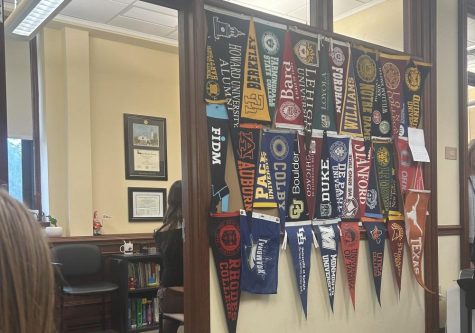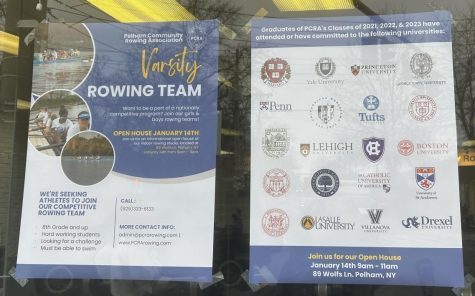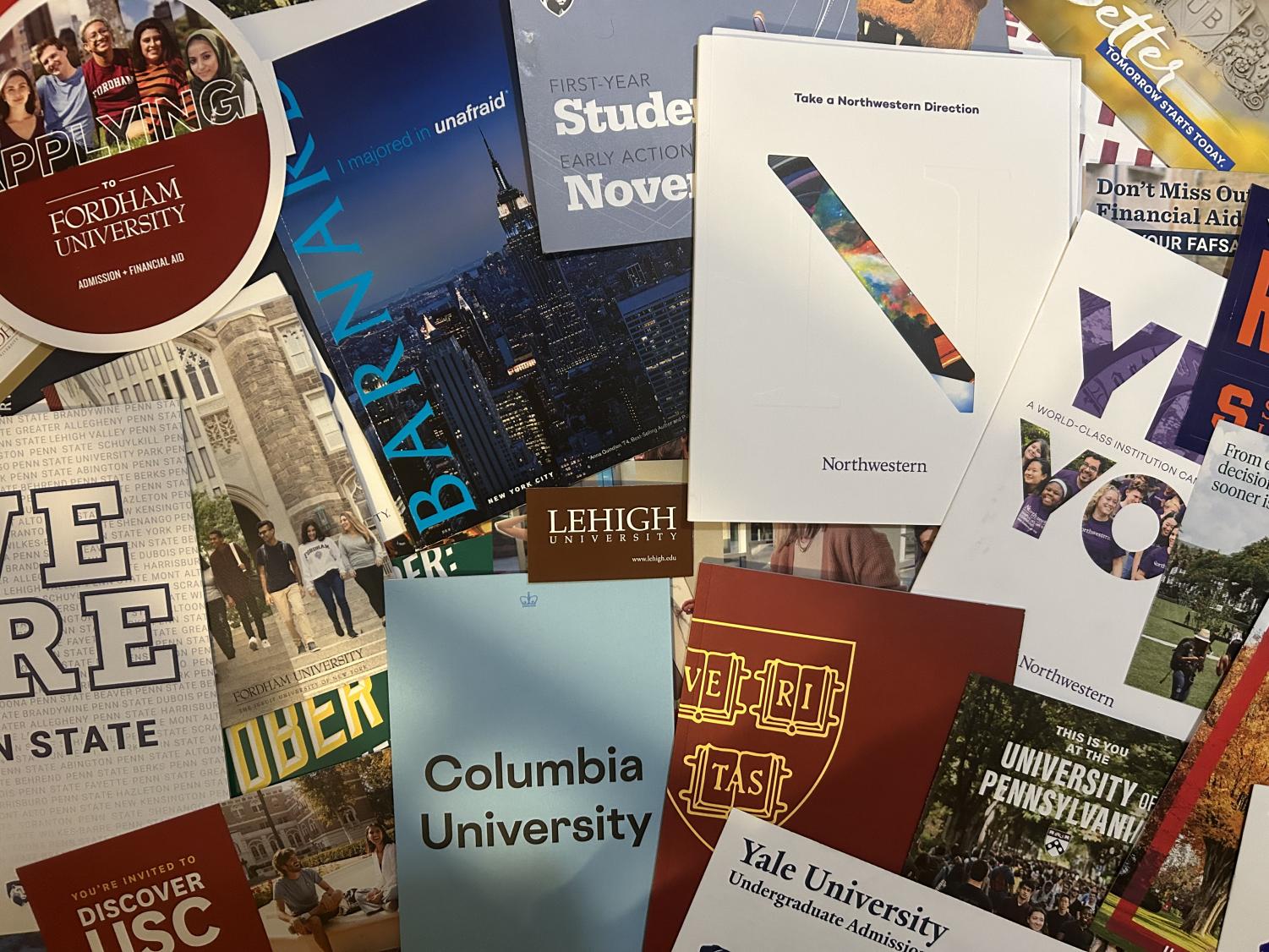The good, the bad and the Ivy: Pelham and the college admissions process
May 13, 2023
As high school juniors make their transition into the college admissions process toward the end of the academic year, they’re met with hundreds of mailings, email pitches and other advertisements from schools across the country and overseas.
Mixed in with state schools and lesser-known institutions are colleges and universities labeled “sweatshirt schools” by one teacher at Pelham Memorial High School. The eight Ivy League schools, the University of Virginia, Wake Forest University and the University of Michigan, which took 12 seniors from the PMHS class of 2022, are among the frontrunners in the minds of many Pelham students applying to college.
“I definitely felt pressure,” said senior Audrey Leung. “I watched my sister and a bunch of her friends apply to a bunch of Ivy Leagues, and a lot of them got in. It’s really intimidating to see all that, and it took me a really long time to understand that I don’t have to go to any Ivy League or a really big and difficult school.”

Reasons vary as to why these institutions are so prestigious in the eyes of Pelham students, parents and educators. Maybe it’s state-of-the-art research facilities, the renowned professors, the location, the environment—or the crimson lettering across the front of that sweatshirt.
“I see my friends applying to all these schools, and I always think, ‘Oh, that’s such a cool school and that it’s so prestigious and that I want to go there,'” said senior Rudy Rocco. “I don’t even know why I want to go there. I just want to go there because it looks cool.”
The pressure can come from personal expectations, classmates, the media or parents and other adult members of the community.
“I feel like there’s a lot of pressure,” said Leung. “Especially if you’re in any AP class, it feels like you’re expected to apply to an Ivy or an equally as good school. It’s intimidating, and the expectations are sometimes really hard to get past. You have to learn to look at what’s right for you and not what everyone else wants to be right for you.”
Students in rigorous programs such as science research also battle these pressures. Before the program moved classrooms last year, students would sign their name and the college they’d be attending on the wall. The expectations were set high by previous classes.
“Especially in (science) research, when kids get into like Ivies and stuff, there’s very much an extended pressure that if you don’t go to a top school that there’s something wrong with you,” said senior Robbie Shepherd. “Along with the externalized pressure, I definitely have some internalized judgements that if I don’t go to a ‘sweatshirt school’ then that means I wasn’t good enough, or even internalized prejudice against going to a SUNY—SUNYs are great schools. But I feel like there’s this judgment like, ‘Oh you weren’t good enough.'”
It’s not just Shepherd who feels that there is a stigma attached to choosing a state school.
“I felt nervous applying to SUNY Binghamton because I feel like there’s a lot of equating more expensive with being a better school, whereas the state schools don’t cost as much so you’re thinking ‘Is that really a good education?'” said senior Clare Pachuta.
But among the thousands of colleges and universities students can attend, how can they feel confident that they picked the right place for them? “Choosing schools out of an infinite list of options is so overwhelming,” said senior Grace Colkin. “I’ve found that after finalizing and submitting my applications, I’m doubting my schools and wishing I had chosen a wider variety.”

For some, the place they chose at 18 years old does not end up being the perfect fit.
“I tried to comply with what others thought was a good match for me,” said Dylan Giglio, a junior at Fordham University who transferred from Haverford College. “It turns out that it wasn’t the right school for me at all. No one should feel bad for making the ‘wrong’ choice. The expectation to know exactly where you want to be when you’ve only lived your life with the family and friends around you for almost 20 years is absurd.”
Beyond the pressure of choosing where to go, Pelham students said there’s much about the process that causes stress and anxiety.
Applicants are expected to write an intriguing essay capturing who they are as a person in 650 words or less. “I’m nervous for writing my essays and not having a specific story or not fitting into what colleges want from me,” said junior Sean McCormick. “It feels like they want a very specific thing. Just because I don’t have that doesn’t mean I don’t deserve to go to a certain school.”
Some of the universities have upwards of eight supplemental essays each, in addition to the main essay required as part of the common application (or common app).
“My experience as an applicant has been extremely stressful, and the use of separate portals was an added annoyance,” Colkin said. “I completed around twenty supplementals across multiple application portals. It consumed my first quarter of senior year and much of my winter break. I have been constantly checking these portals and obsessing over each detail of my applications.”
Applicants are expected to tack on extracurriculars, sports, research, internships and jobs to give their resumes a boost, all while keeping their grades high enough to qualify for the National Honor Society, another achievement they can list on the application.
“After I submitted all my applications, it’s like, I could apply for the English Honor Society this year, but I’m like, why would I?” said senior S Tapogna. “That’s the only reason you do it. Things like that are really just for the application, but a lot of my other extracurriculars are my favorite things.”
A popular question among students—and adults— is, “Did you take the SAT or the ACT?” Students study hours and pay hundreds of dollars to sit for the standardized tests, many taking them multiple times. The tests are upwards of four hours long. Test takers spend the time confined in classrooms bubbling in answers in hopes of getting into the school of their choice, even with many colleges and universities being test-optional for the 2023-24 admissions cycle.
“If someone has the same stats as me, same everything as me, but he has a test score and I don’t, who are they going to pick?” said Rocco. “They’re going to pick the kid with the test score.”
But it’s worth it in the end, right? After hours of testing and essay writing and questions on the applications, you’re bound to have gotten into the perfect school. Not quite.
“Nobody really tells you or prepares you enough for how difficult it is to put your heart and soul into an application only to be rejected,” said senior Lukyan Oppedisano. “Being rejected from my ED1 and ED2 schools and getting deferred from two of my EA schools is hard. It’s difficult especially not to take it personally and to wonder what it is that is wrong with your application and you.”
The comparisons don’t stop during the application cycle, either. On days when decisions come out, students flock to social media to see who’s in and who isn’t. (There is an Instagram account that tracks who’s going where—@pelhamdecisions2023—as well as friends congratulating friends on social media and in group chats as the acceptances hit email inboxes.)
“Comparing the schools you’re applying to with the schools others (are) makes you think, ‘Am I doing the right thing? Am I making the right decision?'” said Leung. “You hear people getting in to college really early on and you’re like, ‘Ok, am I going to get into college? Am I smart enough for this? Is this going to work out for me?’ It’s scary.” Students compare test grades, extracurriculars, resumes and all the other variables to try and see where they fit in on the unpredictable scales of college admissions offices. “It’s really hard because the way that the college process is set up you have to compare yourself to others, which is horribly unhealthy, and it’s disgustingly competitive,” Leung said. “Why should you have to compete to say, ‘I want to learn?'”
Acceptance rates have dropped rapidly year after year as the number of applications climbed, particularly at the good and the Ivy. Many schools this cycle have seen their lowest acceptance rates in history.

“So much of getting into those Ivies has nothing to do with you and everything to do with the demographic that they want to create,” Shepherd said. “You might be everything they’re looking for one year, and the next year they’re like, ‘Oh, no, we have too many of you.'”
Like some, senior Ellie Soderberg has come to the end of the process with mixed feelings. “I feel very relieved to have gotten into college, but I had no help from the school during the process,” she said. “My parents were my only assistance in the process, and I didn’t see my guidance counselor except for one mandatory meeting.”
Soderberg wasn’t the only student who felt this way.
“I wish I had more of a support system or someone that was always open to help with the applications,” said senior Bailey Katz. “Even though I was able to ask my guidance counselor things, it would take them a little longer to get back or they would be busy… I feel that the education that I got while at the high school could have been better at preparing me for the application process. I felt that I was just thrown into this process more than being eased into it.”
Some students had the luxury of a private college counselor (separate from the school’s guidance counselors) aiding them in the application process, at a cost of thousands of dollars in fees.
“These kids are getting the help that they can get, and I get absolutely none of it,” said senior Dorentina Lucjonaj. “This entire college process I’ve literally been alone.”

Liv Pollock • May 12, 2023 at 7:29 am
Something I find interesting is that most of the commentary provided by students surrounds external pressures from peers to “pick the best choice” (aka a “good” or “sweatshirt” school). As someone who graduated last year, and is currently attending (and LOVES) a Pennsylvania state school, I experienced those pressures for months. I remember multiple peers saying “but you’re smart” when I made my decision; what’s interesting is that my school was the perfect place for me (R1 institution, connections to UPMC Hospital, Honors College, etc.). Yes, the college applications process is stressful on its own. But that stress is then compounded with the pressure from peers questioning if one could “do better”. In short, there’s so many reasons someone picks a school, so instead of judging someone for their decision, we should celebrate them for completing the process (and maybe reevaluate our biases around what a “good” school is in the process).
To everyone graduating this year, I am so proud of all of you, and I wish you the best of luck in your future endeavors!
Alan Katzman • May 10, 2023 at 9:44 pm
Sadly, most of the assumptions expressed in this article are simply not true. Example #1: “If someone has the same stats as me, same everything as me, but he has a test score and I don’t, who are they going to pick?” said Rocco. “They’re going to pick the kid with the test score.” FALSE. Example #2: Applicants are expected to tack on extracurriculars, sports, research, internships and jobs to give their resumes a boost, all while keeping their grades high enough to qualify for the National Honor Society, another achievement they can list on the application. FALSE
The college admissions process does not need to be this stressful & the stress is not emanating from the colleges.
Patricia Sabga • May 11, 2023 at 3:50 pm
What a sad indictment of the college admissions process. Well done to the Pelham Examiner for this human-centered look at the unnecessary stress placed on children who simply wish to continue learning. Higher Ed institutions absolutely should be held to account for their role. They have been curating classes for years to game the college rankings lists (notably US News). Universities aggressively market to secondary school students to increase their application numbers and make themselves appear more “selective” – a despicable predatory behavior that raises the hopes of kids who simply would not check every box on an ever-expanding college review committee “wish list”. Early Decision gives a massive competitive edge to students from high-income households, while universities that give preference to legacy applicants perpetuate inequality. And then there is the entire industry of test preparation and private college consultants. Children from high-income households can afford to take that SAT prep course for $1,200 or shell out $4,000 – $10,000 for a private consultant to tell them what to write in their essays and supplementals to help their applications stand out. Higher Ed institutions and the derivative industries that have sprung up around it are feeding off our young.
Harriet Smith • May 10, 2023 at 7:05 pm
This is an excellent article by an outstanding group of young editors to make this community exceedingly proud! Dr Ferrell said several times never lose sight trying so hard for college that you forget about family time. Its a ton of pressure. You can go to a state school and become a doctor lawyer teacher…. It’s cheaper and you will be fine. We could pay the cash so our child could go to a smaller private school where there would be more student teacher time. There are plenty of great schools within reasonable price ranges. Really. Look for the best fit… for what you want to do…what you love…the kind of people you want to be around and what you can afford. Keep pushing though to make the best grades you can and learn all you can… and take little time to figure out what you want to be? Nothing in this process deals with that and kids change majors and lose a lot of time and money because of it. Really. Take some time to think about what it is you would like to do and be.